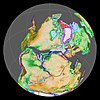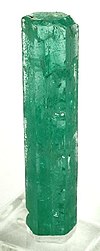Macanal Formation
| Macanal Formation | |
|---|---|
| Stratigraphic range: Berriasian-Valanginian ~ | |
 Outcrop of the Macanal Formation along the road between Bogotá and Villavicencio | |
| Type | Geological formation |
| Unit of | Cáqueza Group |
| Underlies | Las Juntas Formation |
| Overlies | Guavio Fm., Santa Rosa Fm., Ubalá Fm., Chivor Fm., Batá Fm. |
| Thickness | up to 2,935 m (9,629 ft) |
| Lithology | |
| Primary | Organic shale |
| Other | Limestone, gypsum, emeralds |
| Location | |
| Coordinates | 4°58′19″N 73°19′10″W / 4.97194°N 73.31944°W |
| Region | Altiplano Cundiboyacense & Tenza Valley Eastern Ranges Andes |
| Country | |
| Type section | |
| Named for | Macanal |
| Named by | Rodríguez & Ulloa |
| Location | Macanal |
| Year defined | 1979 |
| Coordinates | 4°58′19″N 73°19′10″W / 4.97194°N 73.31944°W |
| Region | Boyacá |
| Country | |
The Macanal Formation or Macanal Shale (Spanish: (Formación) Lutitas de Macanal, Kilm, K1m) is a fossiliferous geological formation of the Altiplano Cundiboyacense and Tenza Valley in the Eastern Ranges of the Colombian Andes. The predominantly organic shale formation dates to the Early Cretaceous period; Berriasian to Valanginian epochs and has a maximum thickness of 2,935 metres (9,629 ft). The Macanal Formation contains numerous levels of fossiliferous abundances. Bivalves, ammonites and fossil flora have been found in the formation.
The formation is a source rock for oil and gas in the Eastern Cordillera Basin and adjacent Llanos Basin foothills and provides emeralds in the vicinity of Macanal, after which the formation is named.
Etymology
The formation was defined and named in 1979 by Rodríguez and Ulloa after Macanal, Cundinamarca.[1][2] The name Macanal is either derived from the Muysccubun word Macana, meaning garrote, or from the Macana palm tree.[3][4]
Description
Lithologies

The Macanal Formation has a maximum thickness of 2,935 metres (9,629 ft), and is characterised by a sequence of micaceous organic shales,[2] with calcite veins and gypsum occurrences intercalated in the formation. The Macanal Formation contains high values of TOC.[5] In the Eastern Cordillera Basin and the adjacent foothills of the Llanos Basin, the Macanal Formation is a source rock for oil and gas.[6] In the vicinity of Macanal, the formation provides emeralds.[7][8]
Stratigraphy and depositional environment
The Macanal Formation, a unit of the Cáqueza Group, concordantly overlies the Guavio, Santa Rosa, Ubalá, Chivor and Batá Formations,[9] and is concordantly overlain by the Las Juntas Formation. The age has been estimated to be Berriasian to Valanginian. Stratigraphically, the formation is time equivalent with the Mercedes, Tambor, Rosablanca, Murca and La Naveta Formations.[10] The formation has been deposited in a shallow marine environment in an enclosed basin,[5] with as provenance areas the Santander High and the Guiana Shield.[11] The Macanal Formation is part of the syn-rift sequence of eastern Colombia.[12]
Fossil content
The Macanal Formation contains numerous levels of fossiliferous abundances. Bivalves, ammonites and flora have been found in the formation.[13] Ammonites of Substeueroceras cf. mutabile, Sarasinella cf. hondana, Subalpinites sp., Berriasela sp., Neocomites cf. wichmanni, Olcostephanus sp., Olcostephanus cf. atherstoni, Favrella cf. colombiana, Acanthodiscus sp. have been registered in the formation, as well as bivalves of Corbis (Sphaera) cf. corrugata, Trigonia cf. hondana, Trigonia (Buchotrigonia) cf. abrupta, Trigonia (Notoscabrotrigonia) cf. tocaimaana, and Exogyra cf. boussingaulti.[14] Analysis of the deformation registered in ammonite fossils has helped in understanding the tectonic history of the Llanos foothills of the Eastern Ranges.[15]
Outcrops

The Macanal Formation is apart from its type locality in the Batá River canyon,[16][17] found in the Cravo Sur anticline, east of the Ocetá Páramo,[18] in the Desespero Synclinal in the southern and northern parts of Labranzagrande,[19][20] around Páez and Campohermoso,[17] in the eastern part of Gama, bordering the Guavio Reservoir,[21] and in the Servitá Synclinal, west of Villavicencio.[22] The Macanal Formation crops out along the road between Bogotá and Villavicencio and is there heavily fractured and folded. The Macanal Formation is the most extensive formation around Cáqueza,[23] and Gachalá, Cundinamarca.[24]
The Pajarito Fault thrusts the Macanal Formation on top of the Fómeque Formation to the east of Lake Tota,[25] and the Chámeza Fault thrusts the Macanal Formation on top of the overlying Las Juntas Formation around Chámeza, Casanare.[26] The Ubaque Fault forms the contact between the Fómeque Formation and the Macanal Formation,[27] while the Las Mercedes Fault puts the Quetame Group in contact with the Macanal Formation near Quetame,[28] as does the San Juanito Fault.[29] The Servitá Fault forms the contact between the Guatiquía Redbeds and the Macanal Formation,[30] and the Upín Fault, part of the same system puts the Macanal Formation in contact with the Tertiary Palmichal Group.[31] At this contact, brines are extracted from the formation.[32]
Regional correlations
- Legend
- group
- important formation
- fossiliferous formation
- minor formation
- (age in Ma)
- proximal Llanos (Medina)[note 1]
- distal Llanos (Saltarin 1A well)[note 2]
See also
Notes and references
Notes
References
- ^ Acosta & Ulloa, 2002, p.51
- ^ a b Rodríguez & Solano, 2000, p.47
- ^ (in Spanish) Official website Macanal
- ^ (in Spanish) Etymology Municipalities Boyacá
- ^ a b Acosta & Ulloa, 2002, p.52
- ^ García González et al., 2009, p.49
- ^ Uribe, 1960, p.5
- ^ ANM, 2015, p.1
- ^ Terraza et al., 2013, p.110
- ^ Villamil, 2012, p.168
- ^ Villamil, 2012, p.165
- ^ Schütz, 2012, p.26
- ^ Patiño et al., 2011, p.45
- ^ Piraquive et al., 2011, p.204
- ^ Montaña Cárdenas, 2015, p.52
- ^ Rodríguez & Solano, 2000, p.46
- ^ a b Plancha 210, 2010
- ^ Plancha 172, 1998
- ^ Plancha 193, 1992
- ^ Pinto Valderrama et al., 2010, p.44
- ^ Plancha 228, 1998
- ^ Plancha 266, 1998
- ^ Patiño et al., 2011, p.44
- ^ Terraza et al., 2013, p.101
- ^ Plancha 192, 1998
- ^ Plancha 211, 2009
- ^ Patiño et al., 2011, p.102
- ^ Patiño et al., 2011, p.110
- ^ Patiño et al., 2011, p.114
- ^ Patiño et al., 2011, p.122
- ^ Patiño et al., 2011, p.123
- ^ Patiño et al., 2011, p.125
- ^ a b c d e f García González et al., 2009, p.27
- ^ a b c d e f García González et al., 2009, p.50
- ^ a b García González et al., 2009, p.85
- ^ a b c d e f g h i j Barrero et al., 2007, p.60
- ^ a b c d e f g h Barrero et al., 2007, p.58
- ^ Plancha 111, 2001, p.29
- ^ a b Plancha 177, 2015, p.39
- ^ a b Plancha 111, 2001, p.26
- ^ Plancha 111, 2001, p.24
- ^ Plancha 111, 2001, p.23
- ^ a b Pulido & Gómez, 2001, p.32
- ^ Pulido & Gómez, 2001, p.30
- ^ a b Pulido & Gómez, 2001, pp.21-26
- ^ Pulido & Gómez, 2001, p.28
- ^ Correa Martínez et al., 2019, p.49
- ^ Plancha 303, 2002, p.27
- ^ Terraza et al., 2008, p.22
- ^ Plancha 229, 2015, pp.46-55
- ^ Plancha 303, 2002, p.26
- ^ Moreno Sánchez et al., 2009, p.53
- ^ Mantilla Figueroa et al., 2015, p.43
- ^ Manosalva Sánchez et al., 2017, p.84
- ^ a b Plancha 303, 2002, p.24
- ^ a b Mantilla Figueroa et al., 2015, p.42
- ^ Arango Mejía et al., 2012, p.25
- ^ Plancha 350, 2011, p.49
- ^ Pulido & Gómez, 2001, pp.17-21
- ^ Plancha 111, 2001, p.13
- ^ Plancha 303, 2002, p.23
- ^ Plancha 348, 2015, p.38
- ^ Planchas 367-414, 2003, p.35
- ^ Toro Toro et al., 2014, p.22
- ^ Plancha 303, 2002, p.21
- ^ a b c d Bonilla et al., 2016, p.19
- ^ Gómez Tapias et al., 2015, p.209
- ^ a b Bonilla et al., 2016, p.22
- ^ a b Duarte et al., 2019
- ^ García González et al., 2009
- ^ Pulido & Gómez, 2001
- ^ García González et al., 2009, p.60
Bibliography
- Template:Cite LSA
- Template:Cite LSA
- Template:Cite LSA
- Template:Cite LSA
- Template:Cite LSA
- Template:Cite LSA
- Template:Cite LSA
- Template:Cite LSA
- Template:Cite LSA
- Template:Cite LSA
- Template:Cite LSA
- Template:Cite LSA
- Template:Cite LSA
Maps
- Template:Cite LSA
- Template:Cite LSA
- Template:Cite LSA
- Template:Cite LSA
- Template:Cite LSA
- Template:Cite LSA
- Template:Cite LSA
External links
- Geologic formations of Colombia
- Cretaceous Colombia
- Lower Cretaceous Series of South America
- Berriasian Stage
- Valanginian Stage
- Shale formations
- Shallow marine deposits
- Source rock formations
- Mining in Colombia
- Colombian emeralds
- Fossiliferous stratigraphic units of South America
- Paleontology in Colombia
- Altiplano Cundiboyacense
- Geography of Cundinamarca Department
- Geography of Boyacá Department
- Geography of Casanare Department
- Muysccubun






























